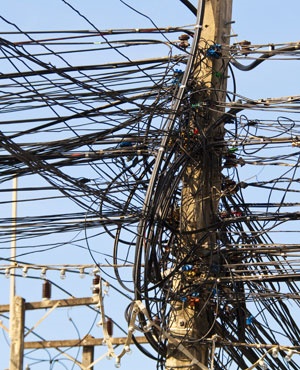Illegal connections and electricity theft run rampant in South African cities, and to fight this problem is a massive challenge.

The general public is regularly encouraged to report illegal electricity connections, and while some may choose to turn a blind eye and let the poor steal what government has not yet provided, other citizens do what they are asked to do and call the designated municipal and Eskom hotlines.
In a growing city such as Johannesburg, home to many informal settlements – especially on the outskirts – illegal connections and electricity theft run rampant.
The route from Johannesburg to EE Publishers’ offices passes an illegal connection hot-spot – the Zandspruit informal settlement in the Honeydew area.
Driving north along Beyers Naude Drive towards Muldersdrift, leading up to the intersection with Peter Road, one passes beneath what can best be described as an “umbrella” of wires, from the tops of streetlight poles, and between trees and structures on either side of the road.
More creative observers aptly refer to the hundreds of illegal connections in plain view as “electric spaghetti”.
On 5 December 2015, and twice thereafter, EE Publishers’ managing director and investigative editor, Chris Yelland, posted photographs of the tangle of wires on Twitter, bringing them to the attention of both Eskom and City Power Johannesburg.
While there was no reaction at all from City Power, to his credit, Eskom spokesman Khulu Phasiwe drove to Zandspruit on a Saturday morning to see the problem for himself, despite question marks as to whether this was a City Power or an Eskom problem.
Phasiwe duly reported back that he had seen what he had to see, and had escalated the matter to Eskom’s area manager, who had arranged to have similar illegal connections in the Zandspruit area removed in the past.
The problem, of course is that the illegal connections simply reappear.
This is hardly surprising as there is a significant demand for electricity in the township, while after 18+ years of its existence, only 268 households have been electrified by Eskom (in 2004), while the balance of some 16 000 residents remain “powerless”.
Clearly massive electricity theft is taking place, but a more immediate concern is safety.
Hundreds if not thousands of unregulated and illegal live wires run through the settlement, where many dwellings are made of corrugated iron.
This makes for an extremely dangerous environment, in which there have been reports of electrocutions, including the death of an infant, and in a separate unrelated incident in December 2015, the death of a young father.
Asked whether they were aware of the electrocution of the baby, City Power’s response was: “We are not aware of the incident as this area falls under Eskom”.
Eskom’s response to the same question was: “Yes, Eskom is aware of the incident.
The matter was investigated and there was no physical evidence to connect Eskom to the incident. Upon arrival at the scene, residents had already removed the illegal connections in the house where the incident took place”.
Yet still nothing was done by Eskom or City Power to remove the hundreds of other dangerous and illegal connections to the other dwellings in plain view in Zandspruit.
But despite the ducking and diving by Eskom and City Power, the question remains – who is actually responsible for electricity reticulation in Zandspruit, and for removing these illegal and dangerous electricity connections?
City Power and Eskom both agree that while the City of Johannesburg is responsible for powering the streetlights and high mast area lighting in Zandspruit, Eskom Distribution is responsible for electrification, electricity reticulation and electricity supply to the households in the area.
Simple logic, common sense and morality surely dictate that instead of finger pointing, Eskom and the City of Johannesburg, as organs of state, should be working together to deal with the illegal connections, electricity theft and the associated safety issues.
Yet despite Chris Yelland having further reported this matter in writing in early January 2016 to the highest levels at both City Power and Eskom, and obtaining two reference numbers from the Eskom Call Centre on 8 January (reference number 163719435 for the safety emergency for which a response time of 24 hours was promised, and reference number 163719433 for the less urgent matter of electricity theft), absolutely nothing has been done to date to attend to the illegal connections.
With regular violent service delivery protests in Zandspruit along Beyers Naude Drive, and local government elections coming up in 2016, it is surely time for government, Eskom and City Power to get their acts together and provide the residents of Zandspruit, who have been waiting for 18+ years, with a basic and safe electricity service.
The policy and regulatory frameworks are well established, and the implementing agencies are in place – so what are we waiting for?
Perhaps it is time for Eskom and City Power to be prosecuted by the Department of Labour for their gross negligence in failing to ensure compliance with the Occupational Health and Safety Act, the associated Electrical Installation Regulations, and the mandatory Code of Practice for the Wiring of Premises, SANS 10142 Part 1. This failure has already led to loss of life.
But I suppose that would be just too much to expect.





